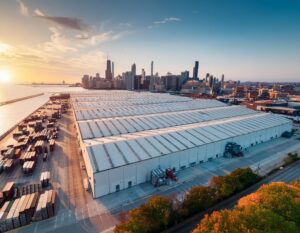- Centralized Location and Connectivity: Chicago’s industrial sector benefits significantly from its centralized location and unmatched rail and highway connectivity, being the only U.S. city with six Class 1 railroads.
- Strong Industrial Market: Over the past 12 months, Chicago absorbed 24.8 million square feet (SF) of industrial space, surpassing the 2006 high of 24 million SF and doubling the metro’s all-time average.
- Leasing Activity Decline: Despite strong absorption, leasing activity has decreased each quarter since the second quarter of 2022, a trend continuing into the year.
- Railroad Developments: The U.S. Surface Transportation Board approved Canadian Pacific’s $31 billion acquisition of Kansas City Southern. This acquisition is expected to shift 64,000 truckloads annually to rail, enhancing safety and reducing emissions. The $380 million Forest Hill Flyover project also aims to reduce rail congestion.
- Robust New Supply: New industrial supply is increasing, with 25.4 million SF coming to market in the past year and another 35.3 million SF under construction, approved during high leasing volume in early 2022.
- Specialized Industrial Space Growth: Local manufacturers are reshoring and modernizing facilities, contributing to the growth of specialized industrial space. The need for multiple sources of materials and distribution networks drives this shift.
- Pre-Leasing Concerns: Over 70% of the current under-construction supply is not pre-leased, with active cranes in the Joliet, North Kane/I-90, Kenosha East, and South I-55 Corridor submarkets. Due to economic uncertainties and financing challenges, construction levels are projected to dip in the delivery rush.
- Rising Rents: Average industrial market rents in Chicago have risen by 7.5% over the past year, with logistics and specialized segments seeing the strongest growth at 8.8% and 5.1%, respectively. Despite this, Chicago’s rent increase slightly lags behind the national average of 8.1%.
Page Contents
- Centralized Location and Connectivity
- Strong Industrial Market
- Rail Freight Developments
- Consumer Demand Trends
- Amazon’s Market Adjustments
- Joliet Area Dominance
- Speculative Space and Vacancy Rates
- Rental Growth
- Chicago’s Rental Growth Trends
- Declining Leasing Volume
- Positive Rental Bumps
- Influence of Small Spaces on Rent
- Notable Lease Examples
- Logistics and Specialized Spaces
- Historical Trends and Future Outlook
- Geographic and Infrastructural Advantages
- Industrial Construction Activity
- Logistics Properties
- Specialized Industrial Properties
- Submarket Growing Pains
- Reduced Construction Starts
- Forecasted Supply Pipeline
- Decline in Sales Volume Velocity
- Investor Preferences
- Private Buyers Leading Transactions
- Recent Opportunistic Sales
- Rise in Sale-Leasebacks
- Low Vacancy Rate
- Modest Price Growth Forecast
- Closing Thoughts
Centralized Location and Connectivity
Chicago’s industrial sector thrives due to its centralized location and excellent rail and highway connectivity. It is the only U.S. city with six Class 1 railroads. This advantage attracts national and local developers. Chicago efficiently serves the Midwest and North America.
Strong Industrial Market
 Chicago’s industrial market absorbed 24.8 million square feet (SF) over the past year, ranking it among the top five U.S. markets, alongside Dallas, Houston, and Phoenix. However, leasing activity has significantly dropped in recent quarters. Developers built most of last year’s 25.4 million SF supply speculatively.
Chicago’s industrial market absorbed 24.8 million square feet (SF) over the past year, ranking it among the top five U.S. markets, alongside Dallas, Houston, and Phoenix. However, leasing activity has significantly dropped in recent quarters. Developers built most of last year’s 25.4 million SF supply speculatively.Rail Freight Developments
Rail freight declines nationally, but local improvements boost Chicago’s prospects. Political challenges remain, but authorities are resolving some conflicts. The Joliet Area’s resurgence highlights its critical role in the nation’s railway system.
Consumer Demand Trends
Consumer demand for hard goods remains strong despite a national drop in container and cardboard sales. Consumer spending is expected to decrease, which will likely impact local distributors and the industrial market.
Amazon’s Market Adjustments
Amazon has reduced its expansion plans, canceling Crystal Lake and Hoffman Estates warehouses. Despite closures, Amazon employs around 25,000 people in Chicago and occupies over 21 million SF. It continues to expand selectively, with new leases in Kenosha, Huntley, and DeKalb.
Joliet Area Dominance
Joliet leads in leasing volume and absorption, recording almost 9 million SF. The South I-55 Corridor also saw strong absorption with 7.4 million SF. Major transactions include leases by Target and Unilever, each taking 1.2 million SF.
Speculative Space and Vacancy Rates
We expect absorption to remain positive, but deliveries will outpace it. This speculative space, lacking pre-leased tenants, will raise vacancy rates. However, analysts project vacancies to stay below the market’s average by at least 200 basis points.
Rental Growth
Industrial market rents in Chicago rose by 7.5% over the past year. Logistics and specialized segments grew most at 8.8% and 5.1%, respectively. Although Chicago lags slightly behind the national average, the market remains strong.
Chicago’s Rental Growth Trends
Chicago’s industrial rental growth was 8.5%. This is down from the peak of 9.6%. It’s still above the all-time and 10-year averages of 2.7% and 4.8%. However, signs suggest rental growth may slow soon.
Declining Leasing Volume
Leasing volume in Chicago has dropped significantly recently. This occurred while industrial inventory expanded, increasing competition among landlords. Average square footage decreased by 30% in the past year, and landlords also increased their abatement packages by 30%.
Positive Rental Bumps
Rental bumps and term lengths are rising. Chicago’s rental growth lags behind port-city rents. Historically, the Midwestern hub has trailed coastal markets. We expect this trend to continue as other U.S. regions grow and Chicago’s population shrinks.
Influence of Small Spaces on Rent
Average market rents are $9.20/SF, influenced by smaller industrial and flex spaces. Larger space leases often secure lower rates. Depending on location and age, big box rents range from $4 to $6.50/SF NNN.
Notable Lease Examples
U.S. Medical renewed a 1.31 million SF lease at $4/SF in the I-88 West Submarket. This property, built in 1986, was used to manufacture sterile gloves. Ryder Systems leased 544,000 SF at $5.65/SF NNN in Central Kane/DuPage.
Logistics and Specialized Spaces
Logistics spaces generally lease for less than specialized or flex properties. However, logistics rents grew by 8.8% year over year. Specialized segment rents increased by 5.1%, and flex space rents rose by 5.2%.
Historical Trends and Future Outlook
Although strong, Chicago’s rental growth historically lags behind port cities. As southern and western U.S. regions expand, Chicago’s growth may decelerate. Population contraction and increasing competition will influence future rental trends.
Geographic and Infrastructural Advantages
 Chicago’s location and infrastructure attract national and international companies. Unlike areas relying on population growth, Chicago ranks in the top five for import and export activity. Manufacturing, retail, and logistics companies seek modern, large distribution centers. Developers have responded by bringing this type of industrial product to market.
Chicago’s location and infrastructure attract national and international companies. Unlike areas relying on population growth, Chicago ranks in the top five for import and export activity. Manufacturing, retail, and logistics companies seek modern, large distribution centers. Developers have responded by bringing this type of industrial product to market.Industrial Construction Activity
Chicago’s industrial construction hit an all-time high of 35.3 million SF over the past year, and deliveries are expected to continue at a high pace. Most developers designate under-construction spaces for logistics. Nearly all the 25.4 million SF delivered in the past year was in the logistics segment.
Logistics Properties
Logistics properties currently have a 4.3% vacancy rate. Dermody Properties purchased the 232-acre former Allstate HQ to build 1.2 million SF of warehouse space. The remaining 125 acres are for build-to-suit tenants.
Specialized Industrial Properties
Specialized industrial properties, including data centers, are increasing in Chicago. Facebook completed a 2.4 million SF data center in DeKalb. CloudHQ plans to deliver its 1.5 million SF “hyper-scale” facility phases from 2024 to 2027—the Class 6b Program incentivized data center construction in Illinois, spurring new projects.
Submarket Growing Pains
Kenosha East and the Joliet Area face growing pains with 4 million SF of speculative industrial space each. Most projects are along major interstates and intermodal terminals. The Third Coast Intermodal Hub in Joliet will deliver 2.3 million SF of warehouse space. Another 2.1 million SF is still in the proposal stage.
Reduced Construction Starts
Construction starts have dropped due to slowed leasing and financing difficulties. Higher interest rates have increased construction costs and cap rates, reducing developers’ resale values. Construction decreased by 45% over the past few quarters and 55% year over year.
Forecasted Supply Pipeline
CoStar forecasts that the supply pipeline will stay elevated. Analysts expect tapering. The current high construction activity aligns with national trends. However, challenges like rising costs and financing issues may impact future developments.
Chicago Industrial Market Sales VolumeThe Chicago industrial market posted the fourth-largest sales volume in the nation at $5.0 billion over the past year. Logistics facilities drove this volume, accounting for $3.5 billion in confirmed transactions.
Decline in Sales Volume Velocity
Sales volume velocity dipped significantly from year-end 2022. Sellers are retracting buildings from the market due to unattractive offers. Rising interest rates and economic concerns are causing hesitancy in capital markets.
Investor Preferences
Investors seek fully leased properties with value-add opportunities. They prefer leases set to expire soon, allowing rent increases to current market rates. This presents opportunities for opportunistic buyers.
Private Buyers Leading Transactions
Private buyers completed most industrial sales transactions. REITs and private equity firms made up the smallest group of buyers. Shawn Clark of CRG noted the unique opportunity to acquire properties at lower prices amid rising costs and cap rates.
Recent Opportunistic Sales
Recent transactions include opportunistic buys for fully leased Class B and C properties. For instance, EQT Exeter purchased a 397,000-SF distribution center in Kenosha for $47 million at a 6.8% cap rate. Last year, a similar property sold for a higher price per SF.
Rise in Sale-Leasebacks
Sale-leasebacks were common over the past year, especially within 3-star investment-grade assets. This trend is ticking up. Businesses with equity in properties see benefits in keeping them rather than redeveloping them.
Low Vacancy Rate
Chicago’s industrial market has a 4.2% vacancy rate. This low vacancy rate and a price per SF higher than the historical average suggest a strong market. However, economic concerns and rising interest rates impact overall sales volume.
Modest Price Growth Forecast
The baseline forecast calls for modest price per SF growth in Chicago’s industrial market. Despite strong fundamentals, rising costs and economic uncertainties temper growth expectations.
Closing Thoughts
Chicago’s industrial market shows strong fundamentals despite economic uncertainties. Investors seek value-add opportunities in logistics and specialized properties. The market remains robust, with modest growth expected. Contact Lumicre for your investment needs.